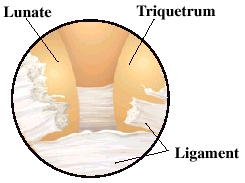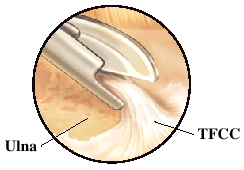Wrist Arthroscopy: Conditions Treated
Wrist Arthroscopy: Conditions Treated
Wrist arthroscopy is used for diagnosis and treatment. It works best for showing ligament tears, damage to the triangular fibrocartilage complex (TFCC), or joint cartilage. Since the wrist is a very small joint, the surgeon uses a special arthroscope.

Ligament tears
The ligaments between the bones of the wrist can tear. This most often happens between the lunate and scaphoid bones or the lunate and triquetrum bones. Such tears can cause pain, swelling, and a weak grip. With a full tear, the bones may pull apart and limit motion. To perform repairs, your surgeon may shift to open surgery.

TFCC damage
Injury or constant use over time can cause a tear in the TFCC (triangular fibrocartilage complex). During surgery, the tear may be shaved off or repaired. Bone or cartilage fragments may be removed. After healing, you should be able to move your wrist with greater ease and less pain.

Cartilage damage
If you have wearing down of the cartilage (arthritis), your surgeon will shave off or smooth the worn area. Bone or cartilage fragments that have chipped off in the joint (loose bodies) will be removed. The removal of loose bodies can help restore smooth, pain-free wrist movement.
Updated:
August 03, 2020
Reviewed By:
Thomas N Joseph MD,Raymond Turley Jr PA-C,L Renee Watson MSN RN